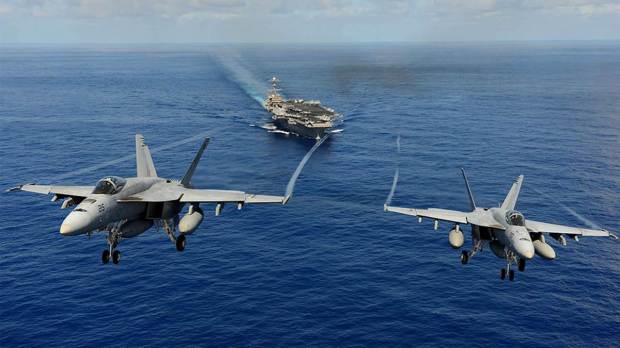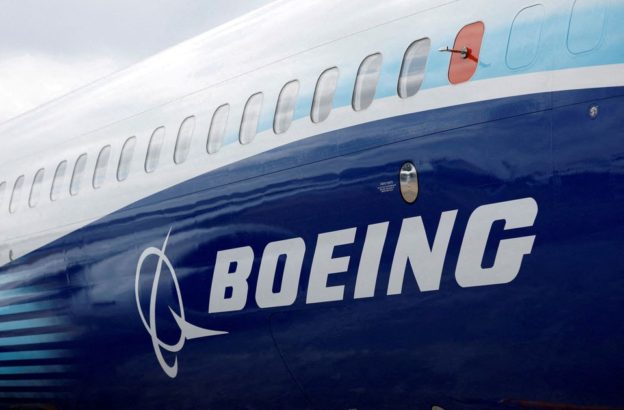Boeing is determined to leverage its supply chain advantage in India and commits to scale up for F/A-18 Super Hornet if selected for Navy. Maria Laine, VP, International Business Development, for Boeing’s Defence, Space & Security share India plans on the sidelines of DefExpo 2022.
Tell us more about the F/A-18 for India and if you could also throw more light on the ‘Make In India’ perspective.
I will have to begin by saying that the F/A-18 is just such an ideally suited product, especially with the aircraft carrier requirement.
In terms of the Boeing story, when we think about the F/A-18 and when we look at other countries where we have sold it in the past, there is a significant portion of that has always been co-produced or assembled in the countries where we have sold it. There is significant parts manufacturing and for India specifically Boeing has been laying the foundation for more than a decade with all our other programs.
We’ve got the JV with TBAL in Hyderabad that is making Apache fuselage, which is for the export customers. Over the last decade, we’ve built a robust global supply chain here in India that is already 300 companies strong. We’re sourcing over $1billion worth of parts and components for Boeing defence products all over the world as well as commercial.
We have such a large defence arm and we’ve got such a strong services business that really integrates all of it. We have local capability to support the products and we’ve had experience now across the world. .
If India wanted to manufacture here, would that be possible?
Everything is negotiable. So, it comes down to what does the customer want, we can absolutely look at what makes most sense. Although we’re already producing F-18 parts and components here in India because we have built out that global supply chain. And I mentioned that they’re producing parts and components that are exported around the world on all our defence products. F/A-18 is already one of those. We have absolutely, as part of our offering, the opportunity to bring a lot more of that F/A-18 work to India. So that is absolutely offered.
If Boeing is selected by the Indian Navy and IAF for MRFA, could there be a possibility for India to be a hub of F/A-18 production line perhaps?
What we prefer to do is that the parts that we are producing, it’s always more efficient for everybody. If you find globally competitive suppliers who are not just producing the part for India alone but then producing it for the rest of the fleet. Just like TBAL is producing the Apache fuselage. It didn’t just produce it for India, it’s producing it for the whole world.

So now, for example, we just got an order for 96 Apache out of Poland. Those Apache fuselages are coming out of India. That will be then part of the Apache product, also in Poland. That’s the business model that makes the most sense. We’ve got that opportunity already for F/A-18 parts being produced here, and there’s more where that came from in terms of if we get selected and chosen, there’s opportunities to do more. Describing just the business model of how we have structured the F/A-18 sustainment. The example that I used, it’s a proven fact because it’s happening in practice.
We have two parallel program requirements from the Indian armed forces about the multi-role fighter aircraft. How would you combine the scale here and in terms of sustainment?
We already have a lot of platforms here in India and that is exactly why we have created our own local entity here to help support that. It’s worked in partnership with the customer, it’s worked in partnership with other local industries as well. We are doing that here to support the current existing platforms. But of course, that can be continuing to be scaled up and it’s all local Indian workforce and that is the smartest way to do this. You know, we continue to build it up and so the more products that we can work on, it’s beneficial to have the OEM capability and knowledge supporting that. It’s done locally by our local India team and together in partnership with the customer and other industry partners.
What about F-15 and the new version– the upgraded one, which is also being offered to India. How do you merge those two offers?
It’s up to the Indian Air Force.
According to you. which one is suitable for India?
I think it depends. The Air Force program is still a little further out. It’s not as mature right now as the Navy program. We must see the final requirements and what it looks like. And then we can deliberate what the right offering is. For the Navy program, we know that the F/A-18 is ideally suited for that requirement being to put the fighter on an aircraft carrier.
India already has another platform which is part of Indian Air Force, ‘the rafale aircraft’ and they have offered an upgrade of that. If the Indian government chooses Boeing they will need to invest in these additional requirements, what is your counter argument for that?
If India has invested and gone to the great lengths of having an aircraft carrier, you really want to make sure you have the right products, right capabilities and the right equipment. And there it comes down to the Indian Navy it needs to take a close, hard look at what is most ideally suited for the Indian aircraft carrier.
We would argue that the F/A-18 for many reasons is the more ideally suited capability. The other aspect that I think is the importance of the bilateral defence relationship with the United States, which continues to grow over the years. It continues to be strategically significant. You think about the elements of the quad relationship and the importance of those government-to-government relations and the ability that could be interoperable and be able to collaborate in this very strategic maritime domain.
You spoke about more strategic aspects, which goes beyond the military equipment. Especially in the maritime, you have P-8I. How does it help the interoperability aspect?
You just hit on a very critical point because it is of huge strategic significance right there. There is no better way for India to capitalise on the great investments it has already made and platforms such as the P8, P-8I and the interoperability and the connectivity between the F/A-18 and the P-8 will just be a force multiplier. So, the ability to get common platforms and systems that really talk to each other and work together, that will be the ideal combination. And that is an advantage. That the F-18 also has, based on the current platforms and inventory of what is in the Indian armed forces, so that’s a huge asset.
https://www.financialexpress.com/defence/boeings-maria-laine-says-fa-18-to-add-strategic-edge-to-indian-navy-to-scale-up-supply-chain/2734708/?utm_source=defence_landing_page&utm_medium=article_listing_widget&utm_campaign=Tags





